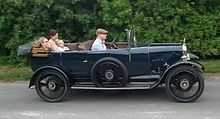Alvis 12/50
| Alvis 12/50 | |
|---|---|
|
| |
| Overview | |
| Manufacturer | Alvis |
| Production |
1923-1932 3705 made [1] |
| Powertrain | |
| Engine | 1496, 1598 or 1645 cc Straight-4 overhead valve |
| Dimensions | |
| Wheelbase | 108 in (2,743 mm) (SA) or 112 in (2,845 mm)[2] |
| Length | 153 in (3,886 mm) to 158 in (4,013 mm)[2] |
| Width | 60 in (1,524 mm)[2] |
| Chronology | |
| Predecessor | Alvis 10/30 |


The Alvis 12/50 is a car introduced by British business Alvis Car and Engineering Company Ltd in 1923. It went through a series of versions, with the last ones being made in 1932. A range of factory bodies (made by Carbodies and Cross & Ellis) could be specified in two- or four-seat form, with either open or closed bodies.
The first models were designated SA and SB and had a 1496 cc 4-cylinder overhead valve engine in a chassis with a wheelbase of 108.5 in (2,756 mm) for the SA and 112.5 in (2,858 mm) for the SB. The engines of these early cars were carried in a subframe bolted to the relatively slender ladder chassis. The SA usually carried two-seat bodywork; often the classic so-called "duck's back" style named after its pointed rear end, which was said to resemble that of a duck. The SA and SB 12/50s were built with brakes on the rear wheels only. All the 12/50s had a four speed non-synchromesh gearbox with right hand change. The cars were right hand drive.
The SC arrived in Autumn 1924 for the 1925 model year with a larger 1598 cc engine (unless the 1496 cc unit was specified for sporting use) and, like all the remaining cars, the longer chassis. Front wheel brakes were offered as an option on this model.
A new stronger chassis was designed and used for the TE of 1926, which had its engine (now built around a redesigned crankcase) enlarged again to 1645 cc, and the TF of the same year which retained the smaller 1496 cc version. A single-plate clutch replaced the previous cone type, and for these and all subsequent 12/50s the engine was bolted directly to the chassis, dispensing with the subframe of previous models. From the TE and TF models onwards four-wheel brakes were fitted as standard.
The TE and TF were superseded in 1927 by the TG and SD with large and small engine respectively. The TG was the standard 'touring' model, while the SD - powered by the 1496cc engine, now fitted with a large-port cylinder head - satisfied the needs of the sporting motorist. Also available in this year was the TH, which had the gearbox and rear axle ratios of the 'touring' TG, but the sub-1500cc engine of the SD. The TG and SD models were available until 1929.
The 12/50 was withdrawn between 1929 and 1930 when the company decided that the future lay with the front-wheel drive FD and FE models, but when these did not reach the hoped for volumes a final version of the 12/50 was announced as the 1645 cc 1931 TJ continuing until 1932. The TJ is referred to by Alvis historians as being from the 'revival period', and it differs from its predecessor in a number of ways, notably coil instead of magneto ignition, deep chromed radiator shell, and rear petrol tank in place of the scuttle-mounted tank on most older 12/50s.

References
External links
| Wikimedia Commons has media related to Alvis 12/50. |